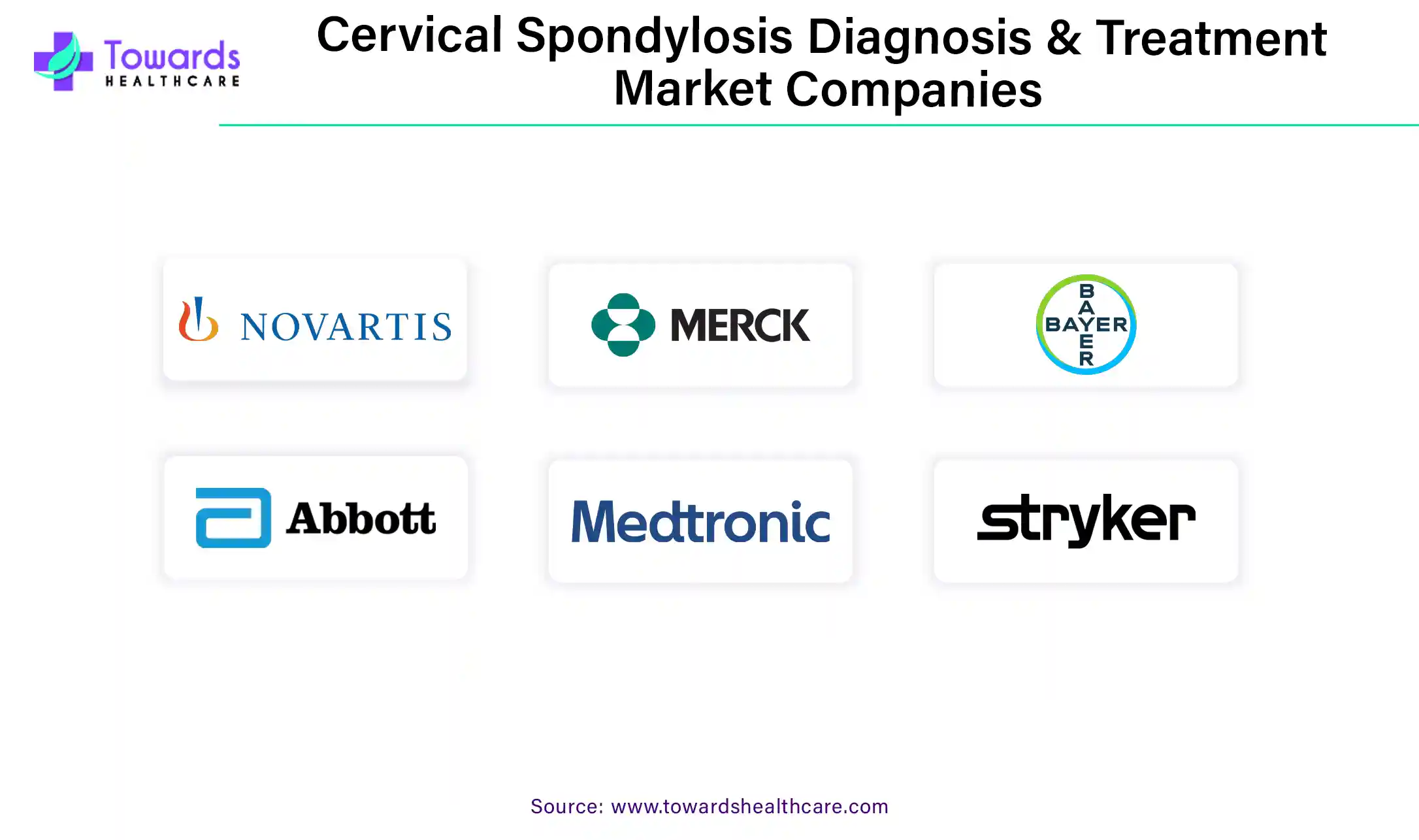April 2025

.webp)
Principal Consultant

Reviewed By
The cervical spondylosis diagnosis and treatment market size is forecasted to expand from USD 7.07 billion in 2025 to USD 12.67 billion by 2034, growing at a CAGR of 6.7% from 2025 to 2034.

In April 2021, according to the American Academy of Orthopedics, over 85% of people aged 60 and above were found to have cervical spondylosis. This means that more and more people are getting this condition, driving the market's growth for treating it.
Cervical spondylosis is a condition that affects the neck and is commonly known as neck arthritis. It typically occurs due to the wear and tear of the bones and cartilage in the cervical spine, which is the part of the spine located in the neck region. Symptoms of cervical spondylosis can include neck pain, stiffness, and discomfort, which may worsen with movement. Some people may also experience headaches, numbness or tingling in the arms or hands, and muscle weakness.
To diagnose cervical spondylosis, doctors usually start with a physical exam to check for neck tenderness, how well the neck moves, and any nerve problems. They might also use imaging tests like X-rays, MRI, or CT scans to better view the neck bones and confirm the diagnosis. Finding cervical spondylosis early is essential because it helps doctors treat symptoms early and avoid possible problems later on.
Treatment for cervical spondylosis aims to relieve symptoms and improve neck function. This can include over-the-counter pain relievers, such as ibuprofen or acetaminophen, to manage pain and inflammation. Physical therapy exercises and stretches may also be recommended to improve neck strength and flexibility.
In some cases, more invasive treatments may be necessary, such as steroid injections to reduce inflammation or surgery to relieve pressure on the nerves in the neck. Surgery is usually considered only when conservative treatments have failed to provide relief.
Preventing cervical spondylosis or managing its progression involves:
Additionally, practicing good ergonomics, such as using supportive pillows and chairs, can help reduce strain on the neck during daily activities. If you experience persistent neck pain or other symptoms, it's essential to consult with a healthcare professional for proper evaluation and treatment.
As people get older, their bodies change, and one standard change is the wear and tear of the bones and cartilage in the neck, known as cervical spondylosis. This condition becomes more likely as we age because our bones and tissues weaken. As a result, the discs between the vertebrae in the neck may start to thin and lose their ability to absorb shock. This can lead to pain, stiffness, and discomfort in the neck.
For instance,
With aging populations worldwide, there's a growing demand for diagnosis and treatment of cervical spondylosis. Older adults are more likely to experience symptoms of cervical spondylosis due to the natural aging process. As they age, the risk factors for developing cervical spondylosis, such as prolonged wear and tear on the spine, become more prevalent.
Additionally, older adults may have other age-related health issues that exacerbate cervical spondylosis symptoms or complicate treatment. This includes conditions like osteoporosis, which weakens the bones and can make the spine more vulnerable to degenerative changes. Given the increased susceptibility of older adults to cervical spondylosis and the potential impact on their quality of life, there's a heightened demand for healthcare services that can accurately diagnose and effectively treat the condition. Healthcare providers may recommend various treatment options, including pain management techniques, physical therapy, and, in some cases, surgical interventions, to help alleviate symptoms and improve mobility in older adults affected by cervical spondylosis.
As the population ages, the prevalence of cervical spondylosis is expected to rise, driving the need for accessible and effective diagnosis and treatment options personalized to the specific needs of older adults.
New advances in diagnostic imaging, such as MRI and CT scans, have greatly improved doctors' ability to detect and treat health issues like cervical spondylosis. MRI uses strong magnets and radio waves to make detailed pictures inside the body, while CT scans use X-rays to create detailed images from different angles.
These advanced imaging techniques have greatly improved the accuracy of diagnosing cervical spondylosis. They allow doctors to see the bones, discs, nerves, and soft tissues in the neck very clearly, helping them pinpoint any problems or damage more accurately. With these more explicit images, doctors can develop more effective treatment plans for cervical spondylosis. They can better understand the extent of the condition and personalized treatments to each patient's specific needs. For example, they can see if there's pressure on the nerves in the neck and plan treatments to relieve that pressure, which can help reduce pain and other symptoms.
For instance,
These imaging techniques are also valuable for monitoring how healthy treatments work over time. Doctors can compare images from different points in time to see if there's been any improvement or if the condition is getting worse, allowing them to adjust treatment plans as needed. MRI and CT scans have revolutionized the diagnosis and treatment of cervical spondylosis, providing doctors with invaluable tools to help patients manage their condition more effectively and improve their quality of life.
Cervical spondylosis happens when the discs and bones in the neckwear are down, leading to pain and stiffness. Better surgical tools like spinal implants have made treatments more effective. These implants support the spine and ease pressure on nerves. Surgeons can now do more accurate surgeries, making them safer with faster recovery.
This has led to significant growth in the cervical spondylosis diagnosis and treatment market. Patients benefit from better surgical options, experiencing reduced pain and improved mobility. The market expansion is also fueled by increasing awareness and diagnosis of cervical spondylosis worldwide. With ongoing research and innovation, the field continues to evolve, offering hope for even better outcomes in the future.
"Lack of awareness among patients" means that many people don't know enough about cervical spondylosis. They might not recognize the symptoms or understand the seriousness of the condition. As a result, they might not seek medical help when they start experiencing neck pain, stiffness, or other symptoms. This lack of awareness can lead to "delayed diagnosis and treatment." When people don't realize they have cervical spondylosis, they might ignore their symptoms or try to treat them with over-the-counter medications instead of seeing a doctor. This delay in getting diagnosed and treated means the condition can worsen over time. By the time they see a doctor and get proper treatment, the cervical spondylosis may have progressed to a more severe stage, making it harder to manage and potentially leading to more complications.
If people need to learn more about cervical spondylosis, they might only realize they have it once it's too late to treat it quickly. This is why raising awareness about the condition is essential, so people can recognize the symptoms and seek medical help sooner.
The landscape for diagnosing and treating cervical spondylosis is quite advanced in North America. Major cities like New York, Los Angeles, and Toronto have specialized medical centers with cutting-edge technology and skilled healthcare professionals specializing in spinal conditions. People living in urban areas generally have better access to these facilities. However, access to quality healthcare can vary in rural or remote areas, with fewer specialized doctors or medical facilities. This can lead to challenges in diagnosing and treating cervical spondylosis for people living in these regions. Insurance coverage also plays a significant role. In the United States, for example, insurance coverage can affect the type of treatments available and the out-of-pocket costs for patients.
In the Asia Pacific region, the landscape for cervical spondylosis diagnosis and treatment varies across countries. In some areas, a growing awareness of the condition leads to increased diagnosis rates. However, awareness levels remain low in many parts of Asia, which still needs to improve, resulting in underdiagnosis and undertreatment. Cultural factors and healthcare practices also influence the market.
For instance,
Traditional medicine is still prevalent in many parts of Asia Pacific, and some patients may prefer alternative treatments over conventional medical interventions for cervical spondylosis. Regulatory environments vary across countries, affecting the availability and affordability of medicines. In some countries, regulatory barriers may hinder the introduction of new technologies and therapies into the market.
The competitive landscape for diagnosing and treating cervical spondylosis, a common condition involving degenerative changes in the spine, involves various healthcare providers and medical device manufacturers. Companies producing diagnostic imaging equipment such as X-ray machines, CT scanners, and MRI machines play a significant role in diagnosing cervical spondylosis. Manufacturers of spinal implants and devices used in surgical procedures for cervical spondylosis treatment are also major players in the market. Pharmaceutical firms that develop and market drugs for pain management, inflammation reduction, and other symptoms associated with cervical spondylosis.

By Diagnosis
By Product Type
By Distribution Channel
By Geography
April 2025
March 2025
January 2025
December 2024